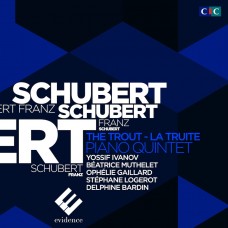您的購物車沒有添加專輯!
搜尋
優席夫.伊凡諾夫 / 舒伯特:鋼琴五重奏「鱒魚」 Yossif Ivanov / Schubert – Piano Quintet 'The Trout/La Truite' ( Ophélie Gaillard cello)
專輯編號: EVCD003
專輯類型: 單CD
發行年份: 2014
國際條碼: 3149028060928
音樂家:
庫存狀態: 有庫存
|
A summit of romantic music played by outstanding musicians and served by an fantastic sound recording signed Nicolas Bartholomée ! Franz Schubert (1797-1828), one of the most brilliant composers of all time, received little or no public attention during his lifetime. His short life was spent largely in Vienna, where chamber music flourished amongst both professionals and amateurs (aristocrats, members of the wealthy middle classes, students). Unlike Beethoven, Schubert did not frequent the salons; most of his music was rarely heard outside his close circle of friends, whose gatherings became known as “Schubertiades”. Not surprisingly, very few of his works were published during his lifetime, and he did not become internationally famous until after his death. The Piano Quintet in A major op. 114 was composed in 1819 (Schubert was twenty-two), at the request of Sylvester Paumgartner, a wealthy music patron and amateur cellist. Its title, Die Forelle (“The Trout”) refers to its fourth-movement set of variations on the composer’s earlier song of that name. The poem (by C.F.D. Schubart) is about a fisherman catching of a trout; by omitting the last verse, Schubert made it descriptive, without the original moral content. The next three works on this programme are transcriptions of songs. Schubert took the lied genre to its apogee, composing over six hundred such pieces and creating a perfect fusion between the voice and the piano. Gretchen am Spinnradeis a setting of a song from Goethe's Faust Part I (published in 1808): while spinning, Gretchen’s thoughts turn to Faust, who has won her heart, and whom she longs to see again. Her agitation and the sound and movement of the spinning wheel are captured admirably in this masterpiece, written when Schubert was seventeen (October 1814). An Sylvia (1826) is Schubert’s setting of a German translation (by E. von Bauernfeld) of the serenade to Sylvia (“Who is Sylvia? What is she…?”) from Act IV, Scene 2 of Shakespeare’s The Two Gentlemen of Verona. The composer was at the height of his powers when he composed this piece; in the same year he produced such masterpieces as his Symphony no. 9 in C major, String Quartet no. 15 (his last), and the four songs from Goethe’s Wilhelm Meister, D. 877. An die Laute(1827), a serenade, is set to a charming poem by Friedrich Rochlitz. The singer softly addresses his lute (“Laute”), asking it to convey to his beloved the secrets of his heart. The compelling Sonatina in D Major, op.posth. 137, no. 1 (1817) is really a sonata for piano and violin (the term sonatina was used to give these pieces greater appeal for amateur musicians). It is heavily influenced by Mozart and Beethoven, Schubert’s principal models, and he unmistakeably quotes Mozart in the first movement, where he takes up the theme from the E minor Violin Sonata K 304. |
|
Franz Schubert 1 Quintette en la majeur op.114 D667 - Allegro vivace 14'15 2 Quintette en la majeur op.114 D667 - Andante 6'55 3 Quintette en la majeur op.114 D667 - Scherzo 4'27 4 Quintette en la majeur op.114 D667 - Andantino 8'03 5 Quintette en la majeur op.114 D667 - Allegro guisto 10'19 6 An Sylvia, op. 106 n°4 2'03 7 Gretchen am Spinnrade, op. 2 3'56 8 An die Laute, op. 81 n°2 1'50 9 Sonatina no.1 Op.137 - Allegro molto 4'21 10 Sonatina no.1 Op.137 - Andante 4'43 11 Sonatina no.1 Op.137 - Allegro vivace 4'28 |
編號 |
曲目 |
長度 |
作詞 |
作曲 |
演奏 |
樂團 |
演唱 |
指揮 |
試聽 |
|---|


